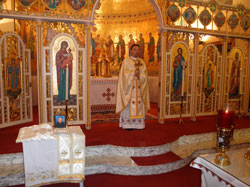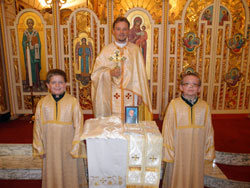After the Divine Liturgy on August 28, 2011 a new set of Festive Gold Priestly Vestments were blessed at the Assumption Catholic Church in Perth Amboy, NJ. The new Vestments were donated to the church by the Senior Citizens Club in honor and memory of their long time Associate Pastor + Rev. Augustine Molodowitz.
Visitors to the Eastern Catholic Church Services may ask why it is that our clergy wear such seemingly peculiar garments. This is a commonly asked question that Catholics ask because they do not know what to call the clothing that is being worn by the clergy. The purpose of this short article is to educate the faithful in the area of priest’s vestments.
The word "Vestment" comes from the Latin. It simply means clothing. Now, vestments are a sacramental. That means they are set apart and blessed by the Church to excite good thoughts and to increase devotion in those who see and those who use them. They are the uniform of the priest when he is "on duty," while he is exercising the functions of his ministry and using the sacred powers which he received at his ordination. The clothing that is worn by the priest while he is not "on duty," it is not called vestments. Priest’s vestments serve to hide and submerge the personality of the priest so that worshippers, seeing Christ through the vestments, may know that it is He, Jesus, who teaches and sanctifies through the priest.
Sticharion – all orders of the clergy wear a special outer garment a robe called a sticharion. This white robe represent the baptismal garment in which every Christian is clothed on his day of baptism. It also signifies the white robe of the angel who announced to the myrrh bearing women the glad tidings of the Lord's Resurrection (Mark 16:5). The clergyman recites the following prayer when he puts on the sticharion: "My soul shall rejoice in the Lord, for He has clothed me with the garment of righteousness and has covered me with a robe of gladness…." (Isaiah 61:10)
Stole or Epitrachelion -the second fundamental vestment for clergy is the stole or epitrachelion which goes around the neck and shoulders. It is the sign of the pastoral office. This vestment symbolizes the grace of the Holy Spirit that flows down abundantly upon the officiating clergy. Adorning the Epitrachelion are two set of tassels; the set on top represents the souls of the living which the priest is responsible for and the set on the bottom represents the souls of those who have fallen asleep in the Lord. The following prayer is recited when this vestment is put on: "Blessed is God who pours out His grace upon His priests, as myrrh upon the head that ran down the beard of Aaron, which ran down to the helm of his garment." (Psalm 133:2)
Cuffs – are worn around the wrists of the priest. Symbolically they represent the creative power of God. The clergyman recites the following prayer when he puts the cuff on his right hand: Your right hand, “ O Lord, is glorified in strength. Your right hand, has crushed the enemies. In the fullness of Your glory You have shattered the adversaries." (Exodus 15: 6-7) While he places the cuff on his left hand he prays: "Your hands have made me and have fashioned me. Grant me understanding and I shall learn from Your commandments." (Psalm 119:73)
Belt – was added as well to hold the vestments in place. This is a belt worn around the waist over the Sticharion and Epitrachelion. It is a sign of the strength given to the priest by the Holy Spirit to lead the community in prayer. The symbolism of the belt is signified by the following biblical passage which the celebrant recites while he fastens it over the Sticharion and the Epitrachelion: "Blessed is God who girds me with strength and makes my way blameless." (Psalm 18: 32-33)
Phelonion – This is a type of sleeveless cloak in the shape of a cone with an opening for the head. It represents the red tunic with which the Romans dressed the Savior before his Crucifixion, and denotes that the priests are invested with truth and should be ministers of the truth. The prayer that the priest says as he puts on the Phelonion is: "Your priests, O Lord, shall clothe themselves with righteousness, and Your saints shall rejoice with joy…." (Psalm 132:9)
The Pectoral Cross – is worn by both priests and bishops as a reminder that they should not merely carry Christ in their hearts, but also confess Him in the face of all men.
 |
 |
 |
